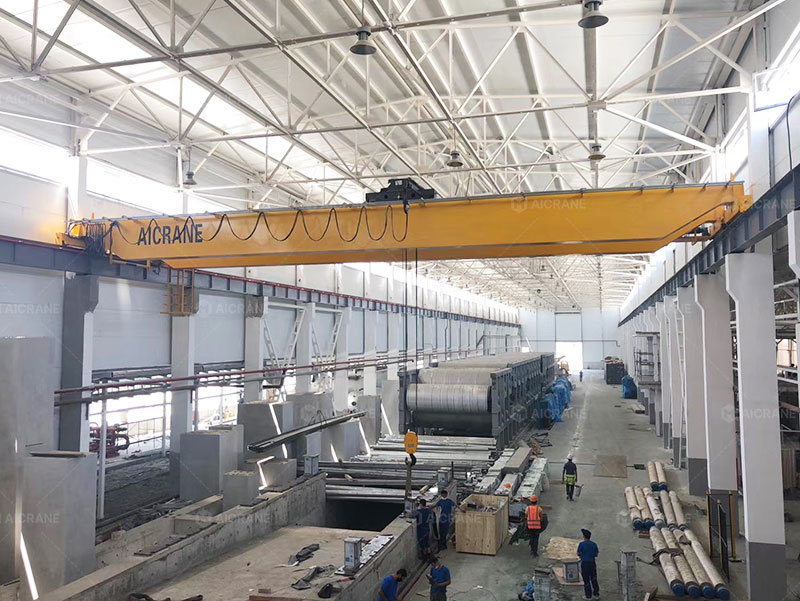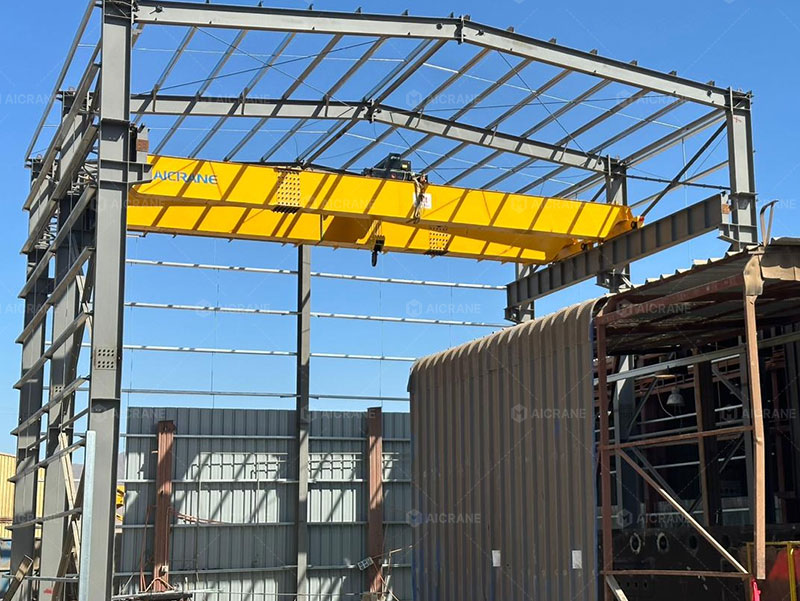Operating a 30-ton overhead crane is an essential task in many industrial settings, including steel workshops, manufacturing plants, logistics centers, and shipyards. While these cranes are designed for heavy lifting, the human factor – particularly the crane operator – plays a critical role in ensuring efficiency, safety, and productivity. One of the most significant challenges faced by crane operators is fatigue, which can lead to reduced concentration, slower reaction times, and increased risk of accidents. Implementing ergonomic principles in crane operation is key to reducing operator fatigue, enhancing performance, and promoting workplace safety. This article explores the importance of ergonomics in 30-ton overhead crane operation, identifies common sources of fatigue, and provides practical strategies for creating a more operator-friendly environment.

Understanding Operator Fatigue in Overhead Crane Operations
Operator fatigue is the physical and mental exhaustion that accumulates over time due to repetitive tasks, sustained concentration, and prolonged exposure to physical and environmental stressors. In the context of 30 ton overhead crane operation, fatigue can stem from several factors:
-
Repetitive Motion: Crane operation involves repeated use of joysticks, buttons, and pedals to control hoist and trolley movements. Over time, these repetitive motions can strain the operator’s muscles, especially in the hands, wrists, shoulders, and back.
-
Prolonged Sitting or Standing: Many crane operators work from fixed cab positions or standing platforms for extended periods. Poor posture and static body positions contribute to musculoskeletal discomfort and fatigue.
-
Visual Strain: Operators must constantly monitor load positioning, crane alignment, and overhead obstacles. Extended focus on small details or moving loads can cause eye strain and headaches.
-
Environmental Factors: Heat, cold, noise, and poor lighting within crane operating areas can amplify fatigue and reduce concentration.
-
Cognitive Load: Operating a 30-ton crane requires constant attention to safety protocols, load limits, and precise movements. Mental fatigue accumulates as operators manage multiple tasks simultaneously.
Recognizing these sources of fatigue is the first step in designing ergonomic solutions that reduce physical and mental stress on crane operators.
Ergonomic Principles for Overhead Crane Operation
Ergonomics is the science of designing equipment, workspaces, and tasks to fit the physical and cognitive capabilities of workers. In overhead eot crane operation, ergonomic considerations focus on reducing strain, promoting comfort, and enhancing operational efficiency. Key principles include:
-
Proper Cab or Control Placement: Whether the operator works in a seated cab or from a ground-level control station, the design and placement of controls should minimize awkward movements. Joysticks, levers, and pedals should be positioned to allow natural hand, arm, and leg movements. Adjustable seats and control panels help accommodate operators of different heights and body types.
-
Optimal Visibility: Operators must have a clear line of sight to the load, crane path, and surrounding environment. Installing wide windows, cameras, mirrors, or sensor-assisted systems reduces the need for excessive neck and torso movements, minimizing strain and fatigue.
-
Adjustable Seating: For operators working in a cab, adjustable ergonomic seating with lumbar support, cushioned padding, and armrests improves posture and reduces the risk of lower back pain. Seats that can swivel or recline slightly allow operators to adjust their position periodically.
-
Reducing Repetitive Motion: Joysticks, push-buttons, and foot pedals should be designed to require minimal force and allow smooth operation. Incorporating multi-function controls and automation for repetitive tasks can reduce the frequency of manual input and the associated strain.
-
Environmental Comfort: Proper lighting, temperature control, and noise reduction in crane cabins or operating areas help maintain alertness. Installing HVAC systems, anti-glare screens, and sound insulation contributes significantly to reducing operator fatigue.
-
Cognitive Ergonomics: Reducing cognitive load through intuitive control layouts, clear labeling, and informative displays improves decision-making and reduces mental fatigue. Operator interfaces should provide real-time feedback on load weight, hoist position, and safety alerts.

Technological Solutions Supporting Ergonomics
Modern 30-ton overhead cranes incorporate advanced technologies that enhance operator ergonomics while improving operational safety and productivity. Some notable innovations include:
-
Remote Control Systems: Wireless remote controls allow operators to control large overhead crane movements from a safe and comfortable distance. By eliminating the need to remain in a fixed cab, operators can move freely, reducing physical strain and improving visibility of the load and workspace.
-
Operator Assistance Systems: Anti-sway, collision avoidance, and load positioning systems minimize the need for manual corrections, reducing repetitive motion and mental effort.
-
Automated Hoist and Trolley Movements: Semi-automatic or fully automated movements for hoisting and trolley travel reduce repetitive joystick operations, decreasing hand and arm fatigue.
-
Ergonomic Cab Design: Modern cab designs prioritize spaciousness, adjustable seating, optimal control placement, and wide visibility, creating a more comfortable and efficient workspace.
Best Practices to Reduce Operator Fatigue
In addition to ergonomic equipment and technological solutions, operational practices play a crucial role in managing operator fatigue. Some best practices include:
-
Scheduled Breaks: Regular breaks allow operators to rest, stretch, and recover from prolonged static postures. Even short 5-10 minute breaks every two hours can significantly reduce fatigue.
-
Rotation of Tasks: Rotating operators between different tasks or crane stations prevents prolonged exposure to repetitive motions and cognitive load, helping to maintain alertness and reduce musculoskeletal strain.
-
Physical Fitness and Stretching: Encouraging operators to engage in light exercises and stretching routines can strengthen muscles, improve posture, and reduce the risk of strain-related injuries.
-
Training and Awareness: Providing training on proper ergonomic practices, correct posture, and safe crane operation techniques empowers operators to adopt behaviors that reduce fatigue and enhance safety.
-
Monitoring and Feedback: Implementing systems to monitor operator workload, crane usage patterns, and ergonomic risk factors helps managers identify areas for improvement. Feedback can guide adjustments to cab design, control layouts, and work schedules.
The Benefits of Ergonomic Overhead Crane Operation
Integrating ergonomics into 30-ton overhead crane operation offers multiple benefits:
-
Enhanced Operator Safety: Reducing physical strain and mental fatigue decreases the likelihood of errors, accidents, and injuries.
-
Improved Productivity: Comfortable, alert operators can perform precise movements more efficiently, reducing cycle times and increasing operational output.
-
Long-Term Health Benefits: Ergonomic practices reduce the risk of musculoskeletal disorders, eye strain, and repetitive motion injuries, contributing to long-term operator well-being.
-
Operational Cost Savings: Fewer accidents, injuries, and downtime lead to lower operational costs and higher equipment utilization.
-
Employee Satisfaction: Operators who work in ergonomic environments experience less discomfort and fatigue, improving job satisfaction and retention.
Conclusion
Ergonomics is a critical consideration in the operation of 30-ton overhead cranes. By addressing physical, cognitive, and environmental factors, overhead crane manufacturers and operators can significantly reduce fatigue, enhance safety, and improve productivity. Proper cab design, control placement, adjustable seating, operator assistance systems, and best operational practices all contribute to a more comfortable and efficient workspace. In today’s industrial environment, investing in ergonomic solutions for overhead crane operations is not just about compliance or comfort – it is about maximizing human performance and ensuring safe, effective, and sustainable operations.
For companies operating 30-ton overhead cranes, prioritizing ergonomics means fewer accidents, healthier operators, and more efficient workflows. Whether implementing modern cab designs, remote control systems, or scheduled task rotations, each step toward ergonomic optimization contributes to reducing fatigue and increasing operational excellence.